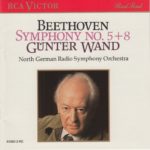
My work station this morning is under the Golden Arches.
That’s right: McDonald’s, the world-famous restaurant chain known for its French fries, Big Macs, Egg McMuffins…and food seemingly extruded from the same stuff so that it tastes the same and looks the same the world over.
I decided to stop here for an hour or so while I write this morning’s blog entry. In no way should anyone read into my choice of “office” this morning that I think Gunter Wand offers up McBeethoven for our listening pleasure.
And that’s why I’m here: to listen to German conductor Gunter Wand (1912-2002), The North German Symphony Orchestra, and Beethoven’s Symphony No. 5 in C minor.
Oh, and sip a McCafe coffee (with two creams, thank you very much).
I’m more than half way into my 162-day project. I have four symphonies and 74 days to go. Then, I switch over to the complete works of Mozart from the new Mozart 225 box set (200 Days With Mozart And Me). I toyed with the idea of adding to my Beethoven project (because I’m having so much fun; plus, there are at least as many conductors/orchestras left from which to choose). But I think I’d like to delve into the Mozart box.
 I have experienced Maestro Wand’s leadership four times previous to this morning, on…
I have experienced Maestro Wand’s leadership four times previous to this morning, on…
Day 17. Rating: “Huzzah!”
Day 35. Rating: “Huzzah!”
Day 53. Rating: “Huzzah!”
Day 71. Rating: “Meh!”
What will today’s McPerformance bring?
I’ll know in a moment.
 Beethoven wrote his symphonies in four parts (except for the Sixth, which is in five). The time breakdown of this particular one (Symphony No. 5 in C minor), from this particular conductor (Wand, at age 75) and this particular orchestra (North German Radio Symphony Orchestra), at this particular time in history (February 25-27, 1987) on this particular record label (RCA Victor Red Seal, now owned by Sony) is as follows:
Beethoven wrote his symphonies in four parts (except for the Sixth, which is in five). The time breakdown of this particular one (Symphony No. 5 in C minor), from this particular conductor (Wand, at age 75) and this particular orchestra (North German Radio Symphony Orchestra), at this particular time in history (February 25-27, 1987) on this particular record label (RCA Victor Red Seal, now owned by Sony) is as follows:
I. Allegro con brio (C minor)………………………………………………………7:14
II. Andante con moto (A♭ major)…………………………………………..9:35
III. Scherzo: Allegro (C minor)……………………………………………………5:14
IV. Allegro (C major)……………………………………………………………….10:23
Total running time: 32:26
My Rating:
Recording quality: 4 (a bit of top end missing, but hardly any tape hiss or ambient sounds)
Overall musicianship: 5
CD liner notes: 4 (a booklet in each CD jewel case; the essays on Symphonies 2 and 4 are brief but informative. In addition, the bulk of the text is in German, although the essays are also translated into English and French )
How does this make me feel: 5 (“Huzzah!”)
I wasn’t sure I was going to like this performance.
The tempo in the all-important Movement I was right on the cusp between just right and too fast. But I kept listening.
I listened all the way to the end of the fourth movement, and then started again at the beginning – and listened all the way through again.
As I discovered from previous listening to Maestro Wand’s performances, there’s a palpable energy, magic, and passion to these recordings. I get caught up in the enthusiasm. In this case, I was especially gripped by the triumphant Movement IV.
Listening to my two favorite movements (III: Scherzo and IV: Allegro) was like listening to the score to one of my all-time favorite movies: The Adventures of Robin Hood, starring Errol Flynn and Olivia de Havilland, soundtrack by Erich Wolfgang Korngold.
By that, I mean it was moving, energetic, majestic, even somewhat pompous. It swept me away. I could feel my head bobbing and my toes tapping. The two combined sounded like the soundtrack to some unseen movie about heroism and swordplay and good overcoming evil.
Plus, there’s that wonderful pizzicato and flute portion of the Scherzo. Done right that, alone, is enough to keep me engrossed. And this was done right.
I used to wonder what made for a “Huzzah!” performance, why some recordings moved me, while some just lie there.
I think, after many months of listening to various conductors and orchestras, I have the answer.
There are three things that go into creating a performance worth hearing again. Let’s call these the Three Necessary Elements:
1. The passion and knowledge of the conductor,
2. The skill and knowledge of the orchestra, and
3. The skill and knowledge of the recording engineers
Come to think of it, there is a fourth element, though. But it has nothing to do with predictability and/or categorization. In fact, it is the opposite of predictability and categorization. It’s the magic of all three coming together that transcends all of them combined. It’s the extra special performance where everything clicks.
If any one of those is missing, or dampened a bit, the recording gets a “Meh!” from me.
Three noteworthy examples of all three (or four, counting the “magic” element) coming together are:
Leonard Bernstein’s recordings
Franz Konwitschny’s recordings
Gunter Wand’s recordings
Those three routinely create my favorite music.
Gunter Wand may have not been the flashiest conductor. But he had “It” (whatever “It” is) that enabled his passion for and knowledge of the subject matter to shine.
Every movement in Maestro Wand’s recording stands out, with something fun in it to hear. By the time I got to the Finale (Movement IV), I was hooked.
I have to award this performance/recording with a wholehearted “Huzzah!”
Worthy.
